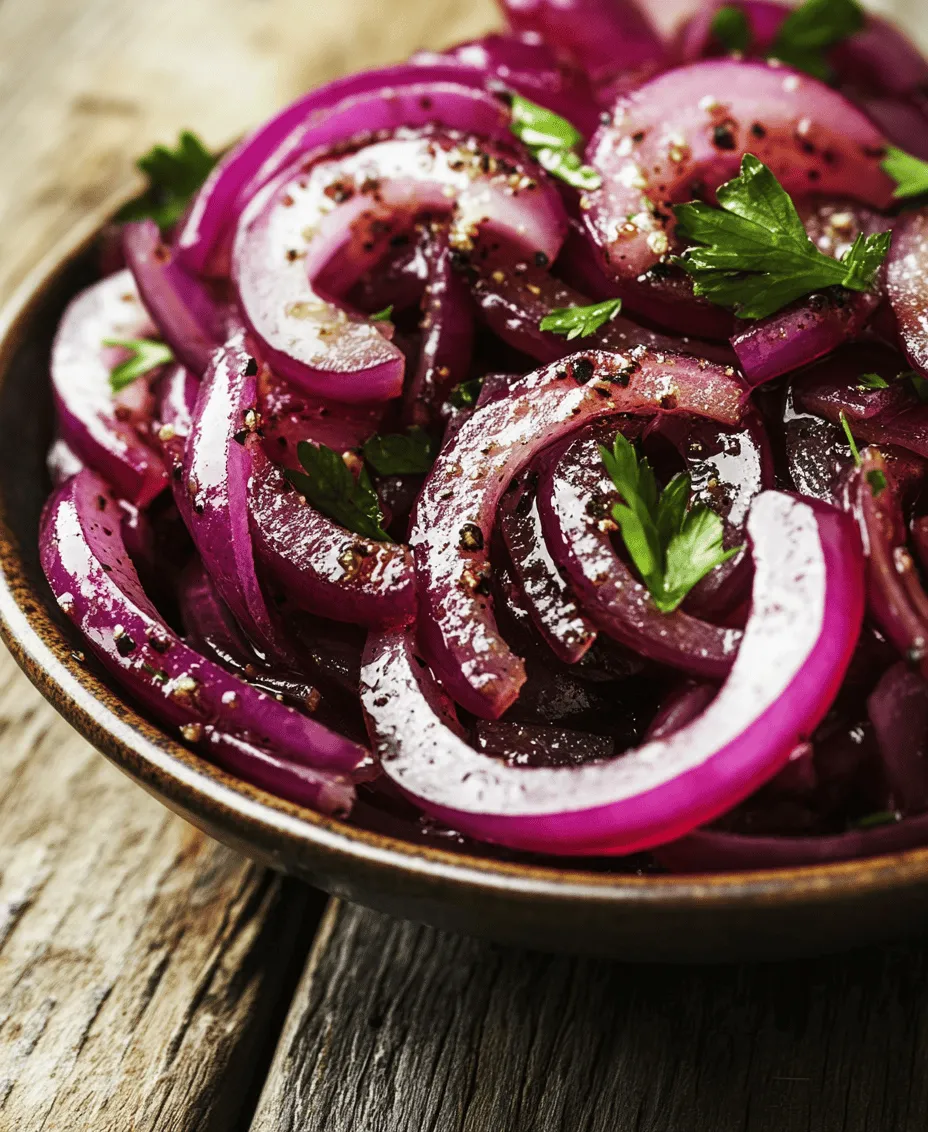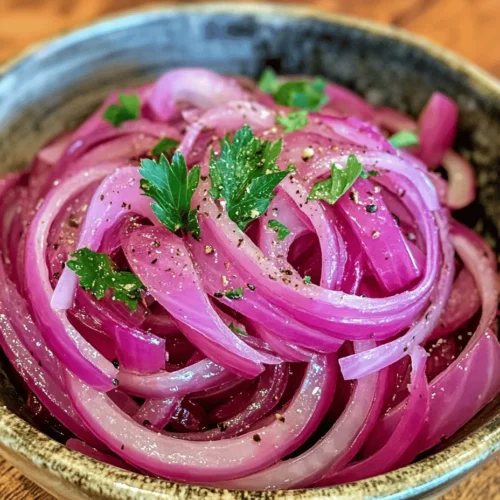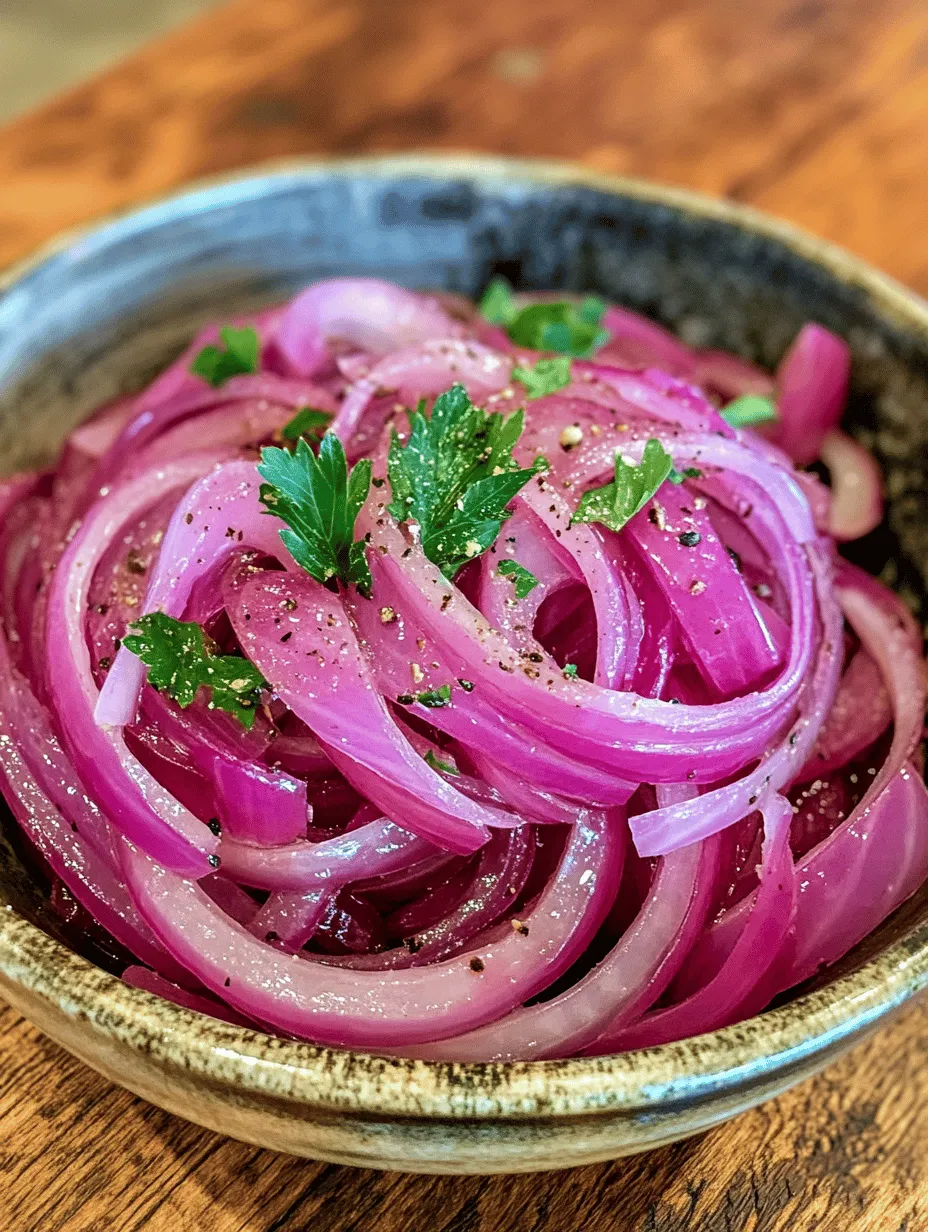Introduction
Sumac onions are a culinary gem that embodies the vibrant flavors and health benefits of Mediterranean cuisine. This dish transforms ordinary red onions into a tangy, refreshing accompaniment that can elevate any meal. The unique sour notes of sumac impart a bright twist to the familiar sweetness of red onions, creating a delightful contrast that is both eye-catching and palate-pleasing. Whether served alongside grilled meats, incorporated into salads, or used as a flavorful topping for flatbreads, sumac onions are incredibly versatile.
Moreover, the health benefits of the ingredients in this recipe add to its appeal. Red onions are known for their rich antioxidant content, which can help combat inflammation and support heart health. Sumac, on the other hand, not only adds flavor but also boasts its own health benefits, including potential antioxidant properties. This dish is not just a feast for the senses; it’s also a nutritious addition to your diet. With a simple preparation process, sumac onions can easily become a staple in your culinary repertoire.
Understanding the Ingredients
To create the perfect sumac onions, it’s essential to understand the role and benefits of each ingredient involved. Here’s a closer look at the components that make this dish shine:
Red Onions
Red onions are the star ingredient in this recipe, renowned for their sharp, slightly sweet flavor and vibrant color. Compared to their yellow and white counterparts, red onions are milder, making them ideal for raw applications. They contain powerful antioxidants, particularly quercetin, which is known for its anti-inflammatory effects and potential to support cardiovascular health. Additionally, red onions provide dietary fiber, which aids in digestion. Their bold color not only enhances the visual appeal of your dish but also indicates a high concentration of beneficial compounds.
Sumac
Originating from the berries of the sumac plant, this spice is a staple in Middle Eastern cuisine. Sumac has a distinct sour flavor that is often described as lemony, making it a wonderful seasoning for enhancing various dishes. Its unique taste can brighten up everything from meats to vegetables. In addition to its flavor, sumac is also known for its antioxidant properties, which can help protect your body against oxidative stress. The use of sumac in this recipe not only adds depth to the flavor profile of the onions but also connects this dish to rich culinary traditions.
Olive Oil
A key ingredient in many Mediterranean recipes, olive oil is celebrated for its health benefits and flavor. Rich in monounsaturated fats, it is associated with a reduced risk of heart disease when used in place of saturated fats. Olive oil also contains antioxidants and anti-inflammatory compounds, making it a nutritious choice for dressing and cooking. In sumac onions, olive oil helps to mellow the sharpness of the onions while enhancing their overall flavor, creating a harmonious blend that elevates the dish.
Red Wine Vinegar
Adding a tangy kick to the sumac onions, red wine vinegar plays an essential role in balancing the flavors. Its acidity cuts through the richness of the olive oil and complements the sweetness of the onions. Red wine vinegar is also known for its health benefits; it may help regulate blood sugar levels and support digestive health. The depth of flavor provided by red wine vinegar is crucial in achieving a well-rounded taste in this dish.
Honey or Maple Syrup
To balance the tanginess of the sumac and vinegar, a touch of sweetness is essential. You can choose between honey and maple syrup based on your dietary preferences. Honey is a natural sweetener with potential antibacterial properties and is often favored for its unique flavor. On the other hand, maple syrup offers a vegan alternative with a distinct taste that can also enhance the overall flavor profile. Both sweeteners contribute to the balance of flavors, making the sumac onions both tangy and slightly sweet.
Fresh Parsley
Fresh parsley serves as a garnish that adds a pop of color and freshness to sumac onions. Beyond its aesthetic appeal, parsley is packed with vitamins A, C, and K, making it a nutritious addition to the dish. Its bright flavor complements the tanginess of the sumac and the richness of the olive oil, enhancing the dish’s overall taste. Including fresh parsley not only elevates the visual presentation but also enhances the dish’s nutritional value.
Step-by-Step Instructions for Preparing Sumac Onions
Creating sumac onions involves a straightforward preparation process that ensures the best flavor and texture. Follow these detailed instructions for a successful outcome.
Salting the Onions
The first step in preparing sumac onions is salting the red onions. This process is crucial as it helps to draw out excess moisture from the onions, resulting in a firmer texture and enhanced flavor. To begin, slice the red onions thinly; this will maximize their surface area and allow the salt to penetrate more effectively.
Place the sliced onions in a mixing bowl and sprinkle them generously with salt. Use your hands to massage the salt into the onions, ensuring that they are well-coated. Allow the salted onions to sit for about 15 to 20 minutes. During this time, the salt will work its magic, drawing out moisture and softening the onions without making them overly salty.
Rinsing and Draining
After the onions have rested and released their moisture, it’s time to rinse them. Rinsing the onions is an essential step to remove excess salt, ensuring that the final dish is flavorful but not overpoweringly salty.
Place the salted onions in a colander under cool running water. Gently rinse them, tossing the onions to ensure that all the salt is washed away. Once rinsed, allow the onions to drain thoroughly. This step is important as excess water can dilute the flavors of the dressing you will soon create.
Making the Sumac Dressing
Now that your onions are properly salted and rinsed, it’s time to prepare the sumac dressing that will flavor the onions beautifully. In a separate mixing bowl, combine the following ingredients:
1. Olive Oil: Measure out a generous amount of extra virgin olive oil. This will serve as the base of your dressing and contribute richness to the dish.
2. Red Wine Vinegar: Add a splash of red wine vinegar to the olive oil, adjusting the amount to your taste. The vinegar will bring acidity and brightness to the dressing.
3. Sumac: Sprinkle in the sumac powder, allowing its tangy flavor to infuse the dressing. The amount of sumac can be adjusted based on your preference for sourness.
4. Sweetener: Depending on your choice, add honey or maple syrup to the mixture. This will balance the acidity from the vinegar and the tanginess of the sumac.
5. Fresh Parsley: Finely chop a handful of fresh parsley and stir it into the dressing. This will not only enhance the flavor but also add a burst of color.
Whisk the ingredients together until well combined. Taste the dressing and adjust the seasoning as necessary, adding more salt or sweetener to achieve your desired flavor profile.
With the dressing prepared, you’re now ready to combine it with the onions, creating a delightful tangy side dish that will enhance any meal.
Stay tuned for the next part of this article, where we will explore how to finish preparing the sumac onions, serving suggestions, and tips for making this dish shine in your kitchen.

Creating the Dressing
To elevate your sumac onions to their fullest potential, it’s crucial to prepare a dressing that strikes the perfect balance between tanginess and richness. Begin by combining high-quality extra virgin olive oil with fresh lemon juice, which serves as the base for your dressing. The olive oil not only adds a smooth texture but also brings heart-healthy fats into the mix, while the lemon juice provides the necessary acidity that complements the raw onions beautifully.
For every medium-sized onion, use about three tablespoons of olive oil and the juice of one medium lemon. This ratio ensures that the onions are adequately coated without becoming overly oily or too sour. Additionally, sprinkle in about one to two teaspoons of sumac. This Middle Eastern spice will contribute its signature tart flavor, enhancing the overall taste profile of your dish. To round out the dressing, consider adding a pinch of salt and freshly cracked black pepper to taste.
Combining Ingredients
Once your dressing is prepared, it’s time to combine it with the sliced onions. In a large mixing bowl, add the thinly sliced onions and pour the dressing over them. Use your hands or a large spoon to gently toss the onions with the dressing, ensuring that each slice is evenly coated. This is an important step, as it allows the flavors to penetrate the onions thoroughly, resulting in a harmonious blend of tastes.
To enhance the infusion, let the dressed onions sit for a few minutes before marinating. This brief resting period allows the sumac and lemon juice to start working their magic, softening the onion’s raw bite and melding the flavors together.
Marination Process
The marination process is where the magic happens. Allowing the sumac onions to marinate offers several benefits that transform the dish from simple to extraordinary. Ideally, let the onions sit in the dressing for at least 30 minutes, but if you have the time, extending this period to up to two hours will yield even better results.
As the onions marinate, they will absorb the tangy flavors from the lemon juice and the earthy notes from the sumac. This not only enhances the flavor but also alters the texture of the onions, making them softer and less pungent. A good marination also promotes the release of the onions’ natural sugars, balancing the acidity and creating a deliciously complex taste.
For optimal results, consider refrigerating the marinated onions if you’re preparing them ahead of time. This will keep them fresh, allowing the flavors to continue developing. Just be sure to bring them back to room temperature for serving, as this will enhance their flavor profile.
Serving Suggestions
Sumac onions are incredibly versatile and can elevate a range of dishes, making them a delightful addition to your culinary repertoire. Here are a few suggested serving ideas to inspire your creativity:
1. As a Side Dish: Serve sumac onions alongside grilled meats or fish. Their bright, tangy flavor cuts through the richness of the protein, providing a refreshing contrast. They pair exceptionally well with chicken, lamb, or even grilled vegetables, adding an exciting twist to your meal.
2. In Salads: Incorporate sumac onions into salads for a zesty kick. They can be a wonderful addition to a simple green salad, or you can use them in grain-based salads like tabbouleh or quinoa salad. Their tanginess will enhance the overall flavor, making your salad more vibrant and interesting.
3. On Sandwiches and Wraps: Use sumac onions as a topping for sandwiches and wraps. They add crunch and flavor, making them a perfect fit for falafel wraps, shawarma, or even classic turkey sandwiches. Their acidity will balance the richness of the meats and spreads, ensuring a satisfying bite every time.
4. In Middle Eastern Dishes: Sumac onions can be featured prominently in traditional Middle Eastern dishes. They are often served as a topping for dishes like kebabs, kabobs, or alongside rice pilafs. Their flavor profile pairs beautifully with the spices commonly found in this cuisine, making them a must-have accompaniment.
Nutritional Benefits of Sumac Onions
In addition to their delicious flavor, sumac onions offer several nutritional benefits that make them a healthful addition to your meals.
Nutritional Profile
A serving size of sumac onions typically comprises about 1/4 cup. In this portion, you can expect approximately:
– Calories: 60
– Carbohydrates: 7 grams
– Fiber: 2 grams
– Sugars: 1 gram
– Fat: 4 grams (primarily from olive oil)
– Protein: 1 gram
This makes sumac onions a low-calorie, nutrient-rich option that can easily fit into various dietary plans.
Health Benefits
Incorporating sumac onions into your diet can provide multiple health benefits. The main ingredients — onions and sumac — are both known for their beneficial properties.
– Onions: Rich in antioxidants, onions are linked to reduced inflammation and improved heart health. They contain quercetin, a powerful antioxidant that may help lower blood pressure and cholesterol levels. Onions also support gut health and can enhance immune function.
– Sumac: This spice is packed with antioxidants and has anti-inflammatory properties. It may aid digestion and help regulate blood sugar levels. Sumac is also known for its antimicrobial effects, which can contribute to overall health.
Together, these ingredients create a dish that not only tantalizes the taste buds but also supports a balanced diet.
Culinary Uses of Sumac Onions in Various Dishes
The versatility of sumac onions makes them a fantastic ingredient in numerous culinary applications. Here are some ways you can incorporate them into your cooking:
– As a Side Dish: Their bright flavor makes them an excellent side for grilled dishes. Try pairing them with grilled chicken or fish for a refreshing contrast, or serve them alongside roasted vegetables for a complete meal.
– In Salads: Use sumac onions to add a burst of flavor to salads. They work well in Mediterranean-style salads, and their tanginess pairs beautifully with feta cheese, olives, and fresh herbs.
– On Sandwiches and Wraps: Sumac onions add a unique flavor profile to sandwiches and wraps. Consider layering them in a pita with falafel or using them as a topping on a grilled chicken sandwich for an extra layer of flavor.
– In Middle Eastern Dishes: Sumac onions are a staple in many Middle Eastern recipes. They’re often served with kebabs and are a key ingredient in dishes like fattoush salad. Their tart flavor complements the spices typical of this cuisine beautifully.
Conclusion
Sumac onions are a tangy and flavorful addition to any meal. Their simplicity, combined with the health benefits of their key ingredients, makes them a compelling choice for those looking to enhance their culinary creations. Whether you choose to serve them as a side, incorporate them into salads, or use them as a topping for sandwiches and wraps, sumac onions are sure to impress.
By experimenting with this recipe, you’re not just adding a new dish to your repertoire; you’re embracing a burst of flavor that has roots in Middle Eastern cuisine. So, gather your ingredients, let the onions marinate, and enjoy the delicious tanginess of sumac onions in your next meal.



